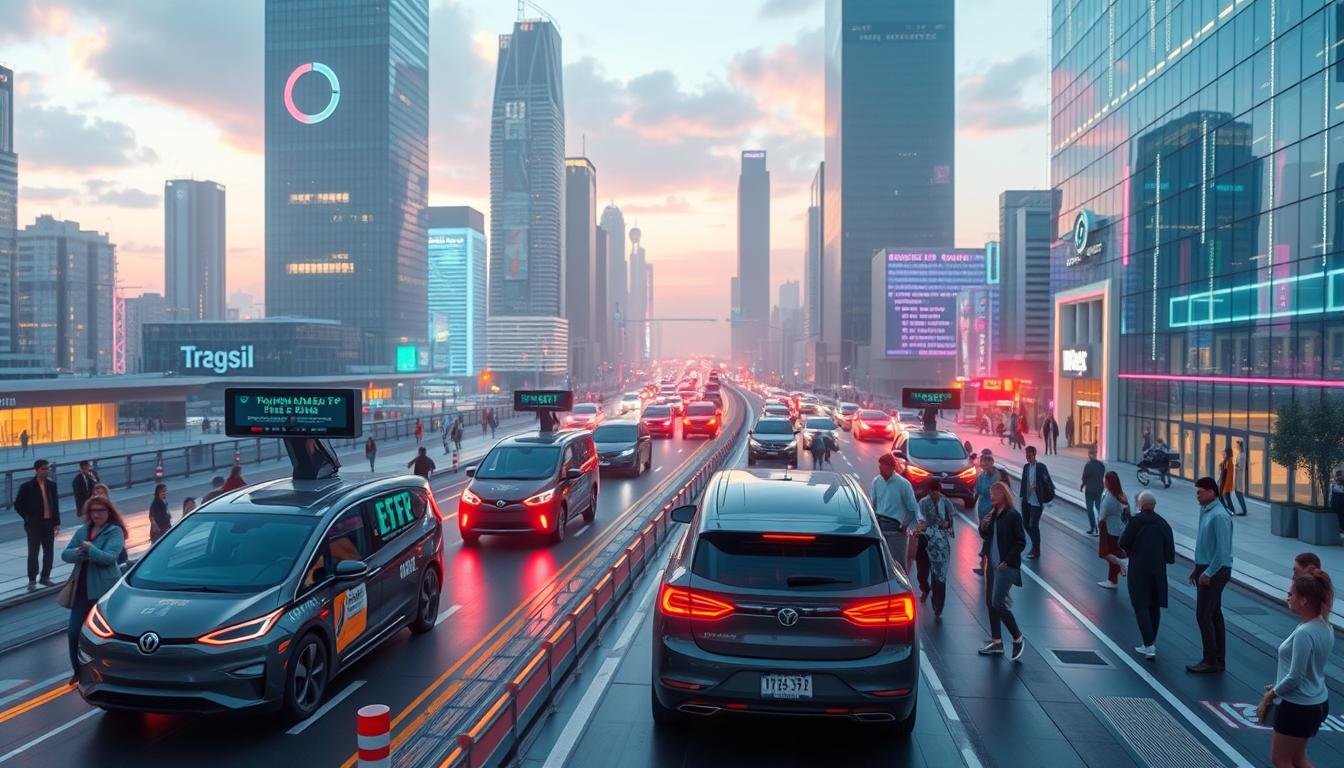Decentralized Ride-Sharing Platforms
The transportation world is changing fast. Decentralized Ride-Sharing Platforms are leading this change. They use Blockchain Mobility Solutions to offer a new way to travel. This new model is all about being open, safe, and putting users first.
At the core of this change is Distributed Mobility Networks. They use Web3 Ride-Sharing to make travel fair and green. These platforms cut out middlemen. This means cheaper rides and more money for drivers, while keeping their data safe.
Key Takeaways
- Decentralized ride-sharing platforms leveraging blockchain technology to create a more transparent and secure transportation ecosystem
- Eliminating the need for intermediaries, leading to lower fare prices and increased driver earnings
- Promoting environmental sustainability by reducing the number of cars on the road
- Empowering users with greater control over their data and transportation choices
- Challenges in scalability and adoption to be addressed for widespread success
The Rise of Decentralized Ride-Sharing
The old ride-sharing scene was ruled by a few big names. But now, decentralized ride-sharing platforms are changing the game. They use blockchain tech to offer a fairer way for drivers and riders to connect.
Exploring the Benefits of Decentralization
These new platforms use blockchain’s strengths like clear data and direct transactions. This makes a better, more people-focused way to move around. Drivers can set their own prices, and riders can share their thoughts, building trust and fairness.
By not needing a single boss, these platforms aim to make travel better for everyone. They want to give a fair shake to all involved.
The Limitations of Centralized Ride-Sharing Platforms
Big ride-sharing companies have faced criticism for how they treat drivers. Issues like the 2016 Uber hack have made people worry about their safety. Experts say we need to move to decentralized services for a safer, more open ride-sharing world.
| Metric | Centralized Platforms | Decentralized Platforms |
|---|---|---|
| Driver Earnings | 60% | 80% |
| Total Taxes | 34.5% | 11% |
| Taxi Fares | Standard Industry Rates | 23% Lower |
| Surge Fees | Yes | No |
Switching to decentralized ride-sharing comes with its own set of problems. But the upside, like more openness and fairness, is worth it. It’s a step towards a better, more just way to get around.
How Blockchain Powers Decentralized Ride-Sharing
Blockchain technology has changed the game for ride-sharing. It offers a new way to share rides that’s different from old models. At the core of this change are smart contracts. They make sure transactions between riders and drivers are safe and clear, without needing a middleman.
Transparency and Trust Through Smart Contracts
Blockchain ride-sharing uses smart contracts for transparency and trust. These digital agreements are recorded on the blockchain. They keep a permanent record of every ride, from booking to payment. This makes sure both riders and drivers can trust the service.
Peer-to-Peer Transactions and Reduced Fees
Blockchain ride-sharing means direct peer-to-peer transactions. This leads to reduced fees compared to old services. For example, Teleport only takes 15% commission, while Uber takes 44%. This helps drivers and riders get a fairer deal.
Blockchain in ride-sharing is a big step towards a fairer and clearer way to move around. It uses smart contracts and peer-to-peer transactions to change the game. These platforms aim to offer decentralized mobility solutions that meet the needs of everyone involved.
Decentralized Ride-Sharing Platforms
The way we get around is changing fast, thanks to decentralized ride-sharing platforms. These new systems use blockchain tech to offer a better, more secure way to travel. They put drivers first and make the whole process more open and fair.
Arcade City is a leading example of this change. It lets riders and drivers meet directly, cutting out the middleman. This means lower costs and a fairer deal for everyone involved.
The growth of Web3 transportation and autonomous mobility networks shows the power of these new platforms. They use blockchain to make travel better for everyone, fixing old problems with the current systems.
“Blockchain-based ride-sharing platforms have the potential to revolutionize the industry, offering a more secure and decentralized alternative to traditional platforms.”
But, there are big challenges ahead. Governments are figuring out how to handle these new systems. Making them work for everyone and solving problems like size and connection are big tasks.
Despite these hurdles, people are really excited about these new platforms. They could make travel better, more fair, and more in control of the users. It’s a chance for the industry to lead and make a big difference.
Drivers and Riders: The Stakeholders in the Decentralized Ecosystem
Decentralized ride-sharing platforms are changing how we move around. They let drivers keep more of what they earn, making their jobs more rewarding. At the same time, they offer riders cheaper and more dependable ways to get around.
Empowering Drivers with Fair Compensation
Blockchain-based ride-sharing makes things fairer for drivers. Platforms like DRIFE give drivers all their earnings, without taking a cut. This approach helps drivers build strong bonds with their riders, creating a sense of community.
Offering Riders Affordable and Reliable Transportation
These platforms also meet riders’ needs, offering them cheaper and more reliable transport. They use blockchain and smart contracts for clear prices and better service. Projects like Teleport and DRIFE are at the forefront of this change, bringing new mobility options to riders.
“Decentralized ride-sharing platforms seek to create a more equitable system that benefits both drivers and riders, fostering a win-win scenario for all stakeholders.”
The Tokenization of Mobility: Introducing DRF Token
The world of ride-sharing is changing fast, thanks to tokenization. At the heart of this change is the DRF Token. It’s a special cryptocurrency made for the ride-sharing world. It makes sure everyone gets paid fairly and safely, thanks to blockchain.
This new way of sharing rides makes things better for everyone. Drivers get paid right, and riders get good deals. It’s all about building a community and making the ride-sharing world grow.
The DRF Token also makes paying for rides easy and cheap. It cuts out middlemen and lowers fees. All transactions are recorded on the blockchain, keeping everything open and trustworthy.
| Key Benefits of the DRF Token | Metrics |
|---|---|
| Secure and transparent transactions | $25.2B in funding to blockchain startups in 2021 (713% YoY growth) |
| Incentivization of active participation | 1.8B B2B cross-border payments on the blockchain by 2025 (up from 122M in 2020) |
| Equitable distribution of value | 3-second transaction time for RippleNet, compared to 5 days for traditional bank transfers |
| Reduced transaction fees | $35T in B2B cross-border transactions expected in 2022 |
The DRF Token is changing the ride-sharing world for the better. It’s all about fairness and using blockchain to make things better. This cryptocurrency is leading the way to a new, fairer ride-sharing future.
The Future of Decentralized Ride-Sharing: Scalability and Adoption Challenges
The ride-sharing industry is moving from centralized to decentralized models. Decentralized platforms face challenges to gain wide acceptance and reach their full potential. Scalability and user adoption are key issues that need to be solved for the future of this new mobility solution.
Scaling for the Future
Scalability is a big challenge for decentralized ride-sharing platforms. These blockchain-based networks must handle more transactions and users without slowing down. Teleport, using Solana’s blockchain, can process thousands of transactions per second. But, scaling is still a big concern as more people use it.
Overcoming Adoption Barriers
Decentralized ride-sharing platforms also struggle with getting users to switch. People might be unsure about leaving familiar platforms. There are also rules to follow that can slow down adoption. Teleport is working to make things easier for users, drivers, and to offer flexible payment options.
The Rise of Web3 Mobility Solutions
The future looks bright for decentralized ride-sharing. New Web3 mobility solutions are coming, powered by blockchain and smart contracts. They aim to make transportation fairer and more sustainable. By solving scalability and adoption issues, these platforms could change how we think about getting around.
In conclusion, the future of decentralized ride-sharing depends on solving scalability and adoption problems. As the industry keeps improving, a more open, clear, and focused on users mobility system is possible. The path to a decentralized ride-sharing revolution is full of challenges and opportunities.
Conclusion: Embracing the Decentralized Mobility Revolution
The rise of decentralized ride-sharing platforms powered by blockchain technology is changing the transportation industry. These platforms cut out the middleman, making it easier for drivers and riders to connect. They aim to make transportation more open, fair, and green.
As the industry grows, it faces challenges like getting bigger and more people to use it. But the decentralized mobility revolution could bring big changes and new ways to solve problems.
Using blockchain-powered transportation makes things safer and clearer, making the system work better. Smart contracts help by making deals automatic, without needing middlemen. Also, making payments easier and rewarding green travel helps make transportation fairer and better for the planet.
By going with this new way of moving people, we can make a better transportation system. It will focus on what everyone needs and help make travel more equitable and sustainable. With teamwork and government help, we can get past the big hurdles and make these new technologies available to everyone. The future of travel is changing, and by joining in, we can make it better for everyone.
Source Links
- Uber Blockchain Platform|Blockchain in Ridesharing
- The Role of Web3 in the Emerging Sharing Economy: From Decentralized Ride-Sharing to P2P Marketplaces
- Article
- Ride-hailing App on Blockchain: Riding the Tale of Decentralized Transformation
- Teleport: Revolutionizing Rideshare on the Solana Blockchain
- Will Blockchain-Based P2P Ride-Sharing Systems Beat The Current Industry Giants?
- Beyond Uber: The Future of Ride-Sharing is Decentralized and on the Blockchain
- Hitching a Ride to the Future: How Soarchain Revolutionize Decentralized Ride-Sharing
- bloXmove to partner with peaq | bloXmove
- Teleport: Revolutionizing Ride-Sharing with Decentralized Marketplaces on Solana
- Revolutionizing the Ride-Hailing Industry with Blockchain Technology
- 65 big industries blockchain could transform | CB Insights Research
- ICO partnership Unlocking Entrepreneurial Potential: ICO Partnerships for Startup Success – FasterCapital
- The Regulation of Marketplace Lending – 2022 Update
- Teleport on Solana | DexterLab
- Cost Efficiency Evaluation of an On-Chain, Decentralized Ride-Sharing Platform
- Decentralized transportation Revolutionizing Mobility: How Decentralized Transportation Is Changing the Game – FasterCapital
- Decentralized Autonomous Transportation: Blockchain in Smart Cities






